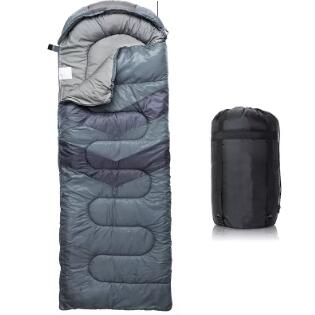Exploring Insulation Types in Camping Sleeping Bags: Performance in Damp or Humid Conditions
2024-02-19
Introduction:
Choosing the right insulation type in a camping sleeping bag is crucial for staying warm and comfortable during outdoor adventures. Insulation plays a significant role in retaining body heat, but its performance can vary depending on the type of insulation used and environmental conditions. In this blog post, we'll explore common insulation types found in camping sleeping bags and how they perform in damp or humid conditions.
Types of Insulation:
Two primary types of insulation are used in camping sleeping bags: down and synthetic. Each type has its unique properties and performance characteristics.
1. Down Insulation:
Down insulation is sourced from the soft under feathers of ducks or geese and is prized for its exceptional warmth-to-weight ratio and compressibility. Down clusters trap air effectively, providing superior insulation to keep campers warm in cold conditions. However, down insulation has limitations in damp or humid environments:
- Performance in Damp Conditions: Down insulation loses its loft and insulating properties when wet, as moisture causes the down clusters to clump together and lose their ability to trap air. Wet down takes longer to dry and may become prone to mold or mildew growth, compromising its effectiveness in damp conditions.
- Water Resistance: To mitigate the effects of moisture, some camping sleeping bags use treated or hydrophobic down, which repels water and maintains loft in damp conditions better than untreated down. However, hydrophobic down is not completely waterproof and still requires proper care and maintenance to prevent moisture absorption.
2. Synthetic Insulation:
Synthetic insulation is made from polyester fibers designed to mimic the insulating properties of natural down. Synthetic sleeping bags offer several advantages over down insulation, particularly in damp or humid conditions:
- Performance in Damp Conditions: Synthetic insulation retains its insulating properties when wet, making it more suitable for damp or humid environments. Synthetic fibers do not clump together like down when exposed to moisture, ensuring consistent warmth and insulation even in wet conditions.
- Quick Drying: Synthetic sleeping bags dry faster than down sleeping bags, as synthetic fibers do not absorb as much moisture and can be wrung out or air-dried more efficiently. This quick-drying property makes synthetic sleeping bags a practical choice for wet or humid camping environments.
- Mold and Mildew Resistance: Synthetic insulation is resistant to mold and mildew growth, making it a more durable and low-maintenance option for humid conditions where moisture accumulation is a concern.
Conclusion:
When selecting a camping sleeping bag, it's essential to consider the type of insulation used and its performance characteristics in damp or humid conditions. While down insulation offers superior warmth and compressibility, it may not perform as well in wet environments and requires careful maintenance to prevent moisture damage. On the other hand, synthetic insulation provides consistent warmth and quick drying properties, making it a practical choice for damp or humid camping conditions. By understanding the performance of different insulation types, campers can choose the most suitable sleeping bag to stay warm and comfortable during their outdoor adventures, regardless of the weather conditions.



